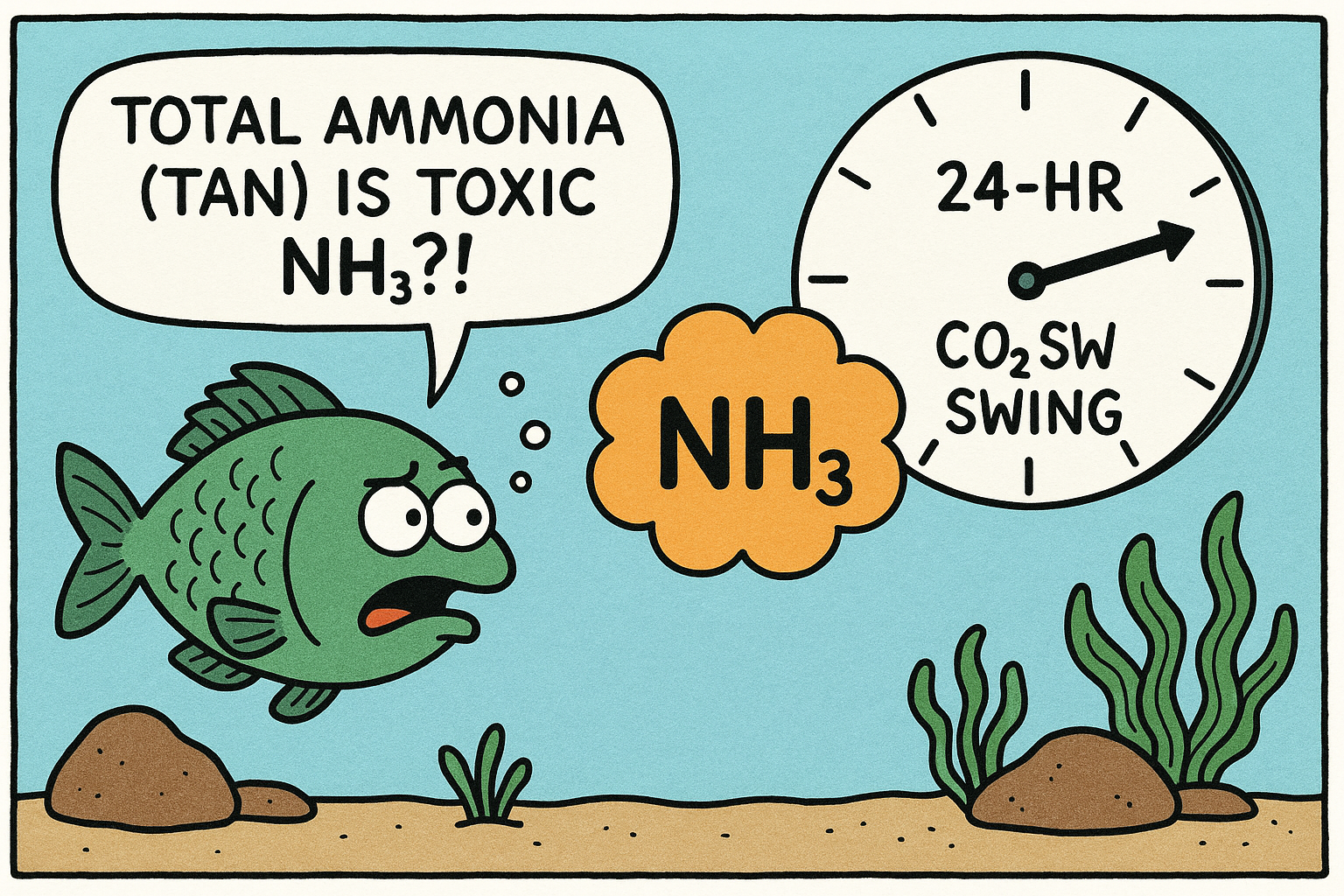At my pH & temp, what fraction of total ammonia (TAN) is toxic NH₃ across a 24-hr CO₂ swing?
NH₃ fraction of TAN across a CO₂-driven 24-hour pH swing
Below is a rigorous, aquaculture-grade way to compute the toxic un-ionized ammonia fraction (NH₃) from TAN at your exact pH/temperature—including how the day/night CO₂ swing amplifies NH₃.
1) Core chemistry (freshwater)
Ammonia in water partitions as:
NH4+⇌NH3+H+The mole fraction of NH₃ in total ammonia (TAN = NH₃ + NH₄⁺) is:
fNH3=1+10(pKa−pH)1For freshwater, the temperature dependence of pKa is well fit by:
pKa≈0.09018+TK2729.92with TK=T(∘C)+273.15.
Result you use: Given your pH and °C, compute fNH3. Then • If your test reads TAN as NH₃ units (mg/L as NH₃): NH3 (mg/L)=TAN×fNH3 • If your test reads TAN as N (mg/L as NH₃-N): NH3-N=TAN(asN)×fNH3 and NH3 (mg/L)=NH3-N×1417.
2) Salinity / ionic-strength correction (brackish & marine)
In saltier water, use a salinity-corrected pKa\*:
pKa\*(T,S)≈(0.09018+TK2729.92)+0.0415S −0.000116Swhere S is salinity in ppt. Then plug pKa\* into the same fraction formula.
Direction of effect: higher salinity → slightly larger pKa → smaller NH₃ fraction at a given pH and °C (the effect is modest but real).
3) What the CO₂ swing does (the “multiplier”)
CO₂ affects pH (not TAN directly). With alkalinity roughly constant over the day, a pH rise at night (CO₂ off / degassing) increases NH₃ non-linearly.
If your pH is well below the ammonia pKa (~9.2–9.5 in typical tanks), a very accurate rule-of-thumb is:
fNH3(pHlow)fNH3(pHhigh)≈10ΔpHSo:
- +0.1 pH ≈ 1.26× NH₃
- +0.3 pH ≈ 2.0×
- +0.5 pH ≈ 3.16×
- +1.0 pH ≈ 10×
This is why even a “modest” night rise can turn a safe daytime NH₃ into a risky nighttime NH₃ without TAN changing at all.
Temperature effect: each +1 °C (at fixed pH) increases the NH₃ fraction by ~7% around typical conditions. If your tank runs warmer at night, include that.
4) Worked examples (26 °C, freshwater)
Using the exact equation above:
- pH 7.0: fNH3≈0.605% of TAN
- pH 7.5: fNH3≈1.888% of TAN
- pH 8.0: fNH3≈5.736% of TAN
- pH 8.5: fNH3≈16.14% of TAN
Across a realistic swing (CO₂ on by day, off at night):
- Day pH 6.8 → Night pH 7.4 (ΔpH = 0.6): fNH3 rises from 0.382% → 1.505% (≈ 3.94×).
- If TAN is 0.50 mg/L as NH₃ units all day: Day NH₃ ≈ 0.0019 mg/L, Night NH₃ ≈ 0.0075 mg/L.
Salinity check (brackish/marine), 26 °C, pH 7.5:
- S = 0 ppt: fNH3≈1.888%
- S = 10 ppt: fNH3≈1.406%
- S = 20 ppt: fNH3≈1.246%
- S = 35 ppt: fNH3≈1.091%
5) How to compute your exact day/night NH₃ right now
- Measure or log:
- Day pH (CO₂ on) and Night pH (CO₂ off)
- Day °C and Night °C
- TAN (ensure units: “as NH₃” vs “as N”)
- Salinity (ppt), if not freshwater.
- Compute fractions using:
- Multiply by TAN in matching units to get NH₃ (mg/L) for day and night.
I placed two interactive tables for you already:
- “NH₃ % of TAN vs pH & Temperature (Freshwater)” — read off your % directly.
- “NH₃ Multiplier Across a pH Swing (Assuming 26 °C)” — see how much the night pH amplifies NH₃ vs day.
There’s also a tiny helper you can run to print your exact % NH₃ at any pH/°C.
6) Practical notes (expert tips)
- CO₂-to-pH mapping: With alkalinity roughly constant, doubling dissolved CO₂ lowers pH by ~0.30; a 10× change shifts pH by ~1.0. You can sanity-check your pH swing against your CO₂ schedule.
- KH matters for swing amplitude: Higher alkalinity damps pH changes from CO₂, helping cap the NH₃ spike without changing TAN.
- When pH ≳ 9, the “10^ΔpH” shortcut breaks down because you’re near pKa; use the exact equation.
- Logging: A cheap continuous pH logger plus one daily TAN test will let you compute a full 24-hr NH₃ profile (peak is typically late night to early morning, when pH is highest).
